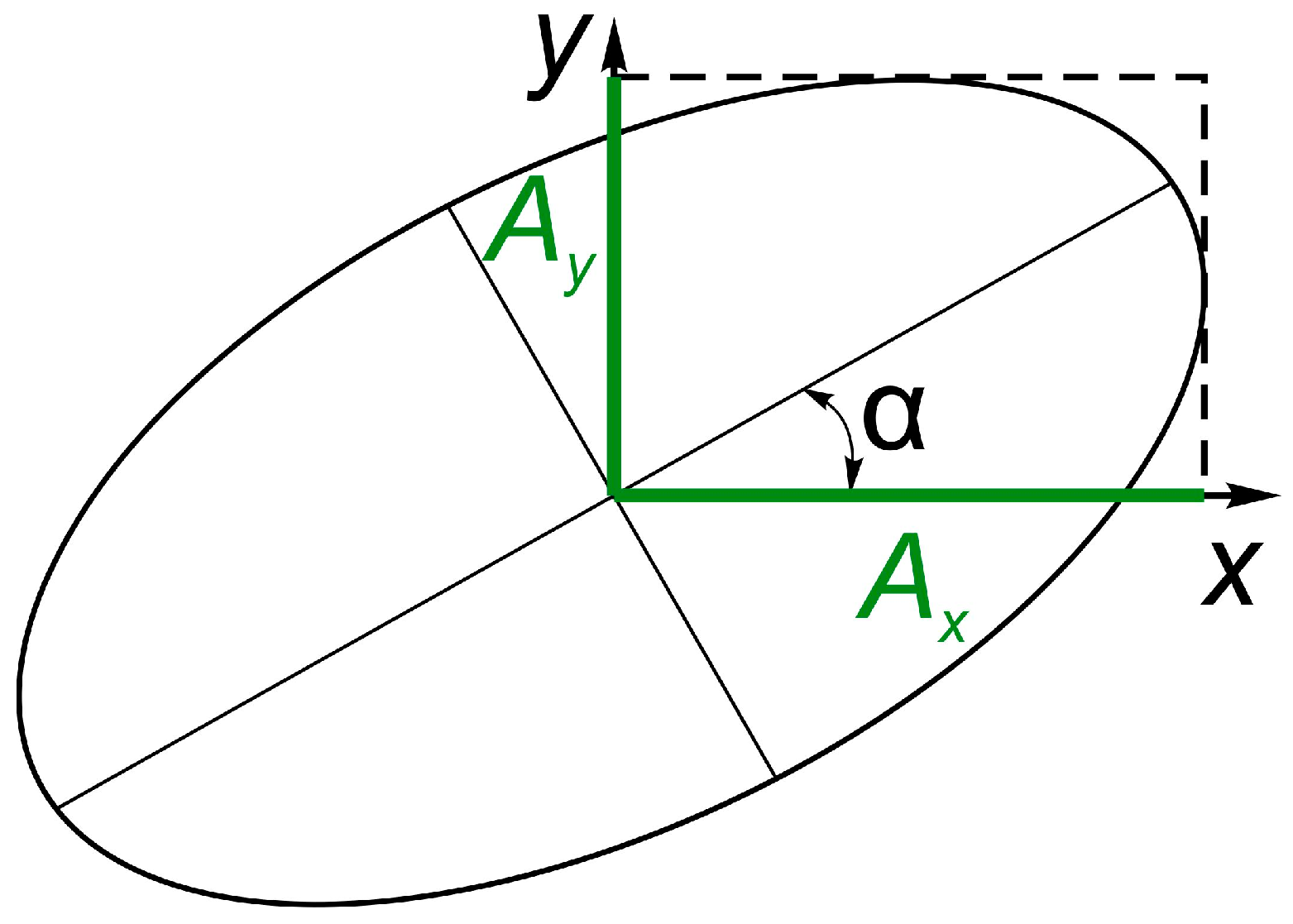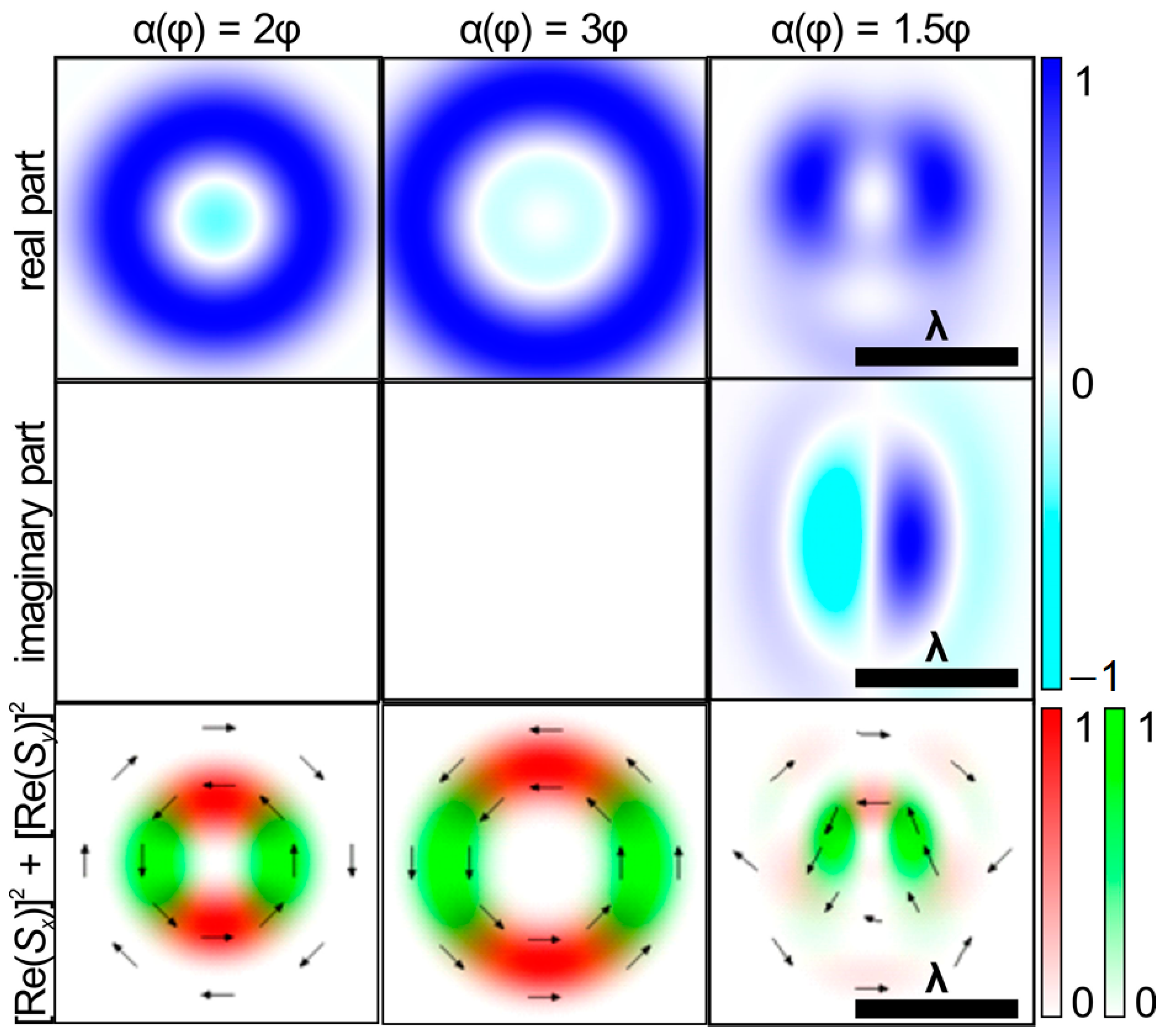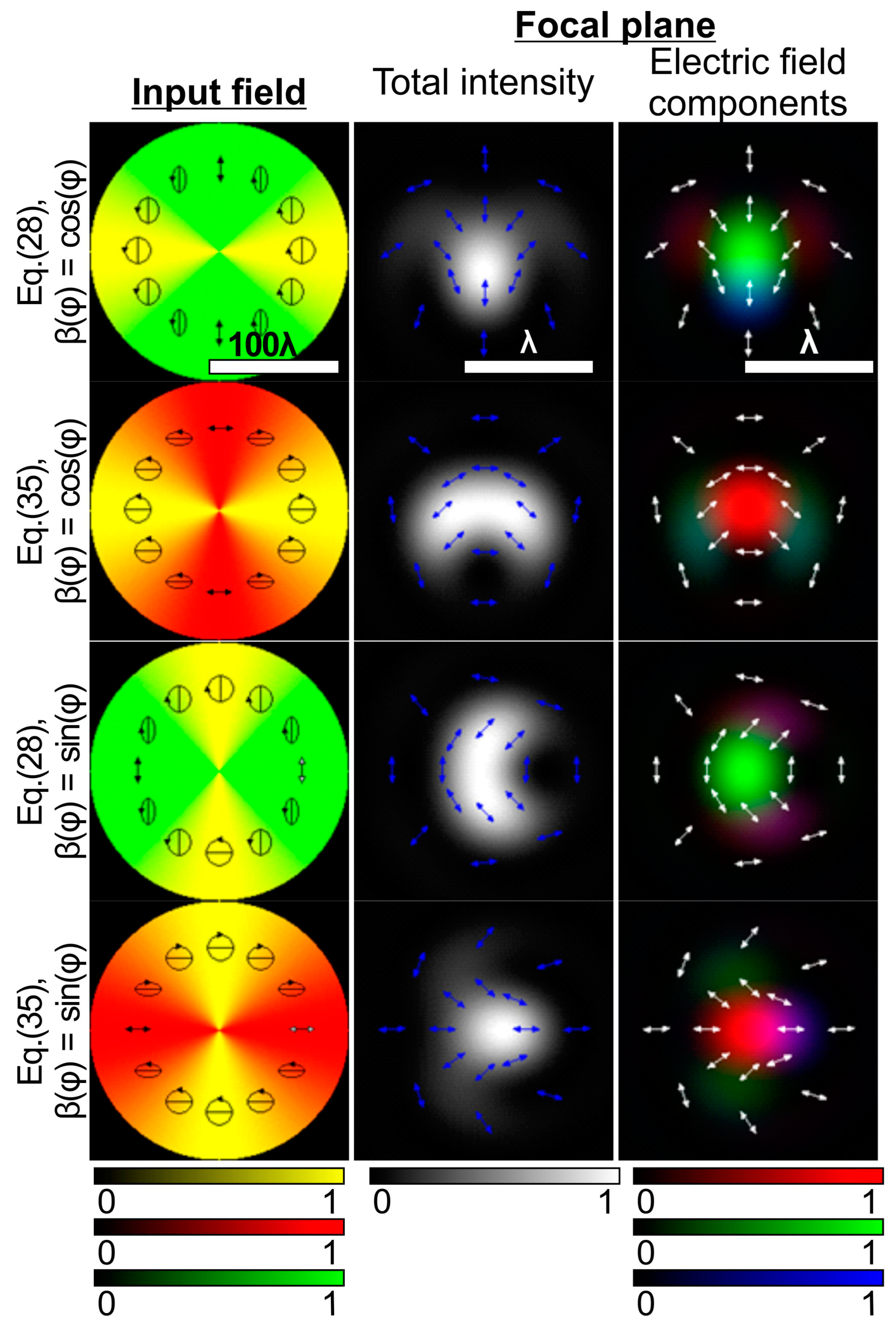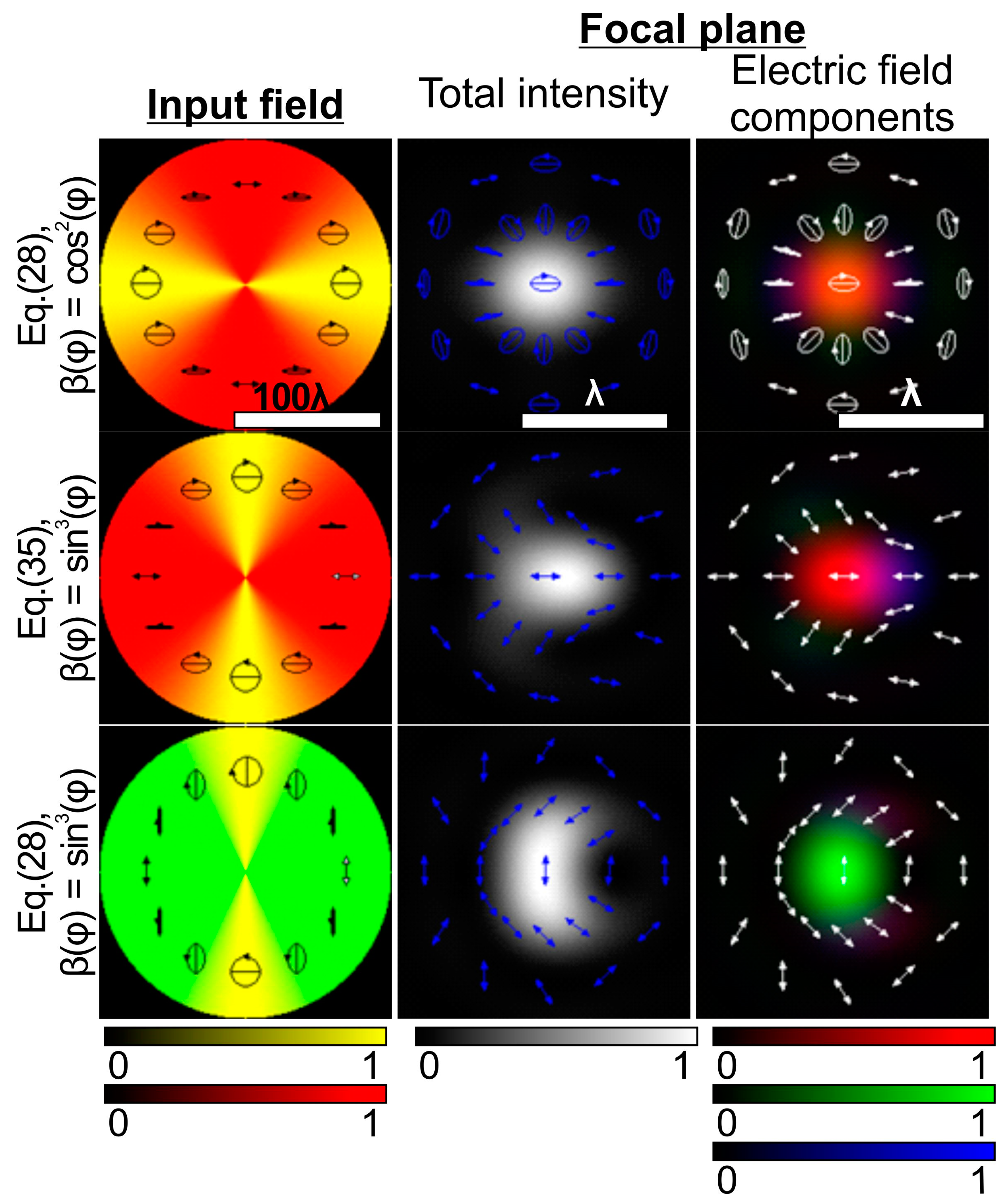Generation of Light Fields with Controlled Non-Uniform Elliptical Polarization When Focusing on Structured Laser Beams
Abstract
:1. Introduction
2. Theoretical Background
- the ratio of the semi-axes (which depends on amplitudes Ax and Ay);
- inclination of the semi-major axis (i.e., angle α);
- vector rotation direction.
3. Results
3.1. Variable Tilt Angle of the Polarization Ellipse
3.1.1. The Tilt Angle of the Polarization Ellipse Is Equal to the Polar Angle
3.1.2. The Tilt Angle of the Polarization Ellipse Is a Multiple of the Polar Angle
3.2. Variable Ratio of the Semi-Axes of the Polarization Ellipse
3.2.1. Simple Trigonometric Dependence on the Polar Angle
3.2.2. Multiple and Power Trigonometric Dependence on the Polar Angle
4. Discussion and Conclusions
Author Contributions
Funding
Institutional Review Board Statement
Informed Consent Statement
Data Availability Statement
Conflicts of Interest
References
- Forbes, A. Structured Light from Lasers. Laser Photon. Rev. 2019, 13, 1900140. [Google Scholar] [CrossRef]
- Angelsky, O.V.; Bekshaev, A.Y.; Hanson, S.G.; Zenkova, C.Y.; Mokhun, I.I.; Jun, Z. Structured Light: Ideas and Concepts. Front. Phys. 2020, 8, 114. [Google Scholar] [CrossRef]
- Forbes, A.; de Oliveira, M.; Dennis, M.R. Structured Light. Nat. Photonics 2021, 15, 253–262. [Google Scholar] [CrossRef]
- Andrews, D.L. Structured Light and Its Applications: An Introduction to Phase Structured Beams and Nanoscale Optical Forces; Academic Press: Cambridge, MA, USA, 2011. [Google Scholar]
- Padgett, M.J.; Bowman, R. Tweezers with a Twist. Nat. Photonics 2011, 5, 343–348. [Google Scholar] [CrossRef]
- Litchinitser, N.M. Structured Light Meets Structured Matter. Science 2012, 337, 1054–1055. [Google Scholar] [CrossRef]
- Du, J.; Wang, J. High-Dimensional Structured Light Coding/Decoding for Freespace Optical Communications Free of Obstructions. Opt. Lett. 2015, 40, 4827–4857. [Google Scholar] [CrossRef] [PubMed]
- Rosales-Guzmán, C.; Ndagano, B.; Forbes, A. A Review of Complex Vector Light Fields and Their Applications. J. Opt. 2018, 20, 123001. [Google Scholar] [CrossRef]
- Angelo, J.P.; Chen, S.-J.; Ochoa, M.; Sunar, U.; Gioux, S.; Intes, X. Review of Structured Light in Diffuse Optical Imaging. J. Biomed. Opt. 2018, 24, 071602. [Google Scholar] [CrossRef] [PubMed]
- Khonina, S.N. Vortex Beams with High-Order Cylindrical Polarization: Features of Focal Distributions. Appl. Phys. B 2019, 125, 100. [Google Scholar] [CrossRef]
- Flamm, D.; Grossmann, D.G.; Sailer, M.; Kaiser, M.; Zimmermann, F.; Chen, K.; Jenne, M.; Kleiner, J.; Hellstern, J.; Tillkorn, C.; et al. Structured Light for Ultrafast Laser Micro- and Nanoprocessing. Opt. Eng. 2021, 60, 025105. [Google Scholar] [CrossRef]
- Yang, Y.; Ren, Y.X.; Chen, M.; Arita, Y.; Rosales-Guzmán, C. Optical Trapping with Structured Light: A Review. Adv. Photon. 2021, 3, 034001. [Google Scholar] [CrossRef]
- Porfirev, A.P.; Kuchmizhak, A.A.; Gurbatov, S.O.; Juodkazis, S.; Khonina, S.N.; Kulchin, Y.N. Phase Singularities and Optical Vortices in Photonics. Phys. Usp. 2022, 65, 789–811. [Google Scholar] [CrossRef]
- Khonina, S.N.; Porfirev, A.P. Harnessing of Inhomogeneously Polarized Hermite–Gaussian Vector Beams to Manage the 3D Spin Angular Momentum Density Distribution. Nanophotonics 2022, 11, 697–712. [Google Scholar] [CrossRef]
- Porfirev, A.; Khonina, S.; Kuchmizhak, A. Light–Matter Interaction Empowered by Orbital Angular Momentum: Control of Matter at The Micro-And Nanoscale. Prog. Quantum Electron. 2023, 88, 100459. [Google Scholar] [CrossRef]
- Prasciolu, M.; Tamburini, F.; Anzolin, G.; Mari, E.; Melli, M.; Carpentiero, A.; Barbieri, C.; Romanato, F. Fabrication of a Three-Dimensional Optical Vortices Phase Mask for Astronomy by Means of Electron-Beam Lithography. Microelectron Eng. 2009, 86, 1103–1106. [Google Scholar] [CrossRef]
- Massari, M.; Ruffato, G.; Gintoli, M.; Ricci, F.; Romanato, F. Fabrication and Characterization of High-Quality Spiral Phase Plates for Optical Applications. Appl. Opt. 2015, 54, 4077–4083. [Google Scholar] [CrossRef]
- Forbes, A.; Dudley, A.; McLaren, M. Creation and Detection of Optical Modes with Spatial Light Modulators. Adv. Opt. Photon. 2016, 8, 200–227. [Google Scholar] [CrossRef]
- Yue, F.; Wen, D.; Xin, J. Vector Vortex Beam Generation with a Single Plasmonic Metasurface. ACS Photonics 2016, 3, 1558. [Google Scholar] [CrossRef]
- Nivas, J.J.J.; Allahyari, E.; Cardano, F.; Rubano, A.; Fittipaldi, R.; Vecchione, A.; Paparo, D.; Marrucci, L.; Bruzzese, R.; Amoruso, S. Surface Structures with Unconventional Patterns and Shapes Generated by Femtosecond Structured Light Fields. Sci. Rep. 2018, 8, 13613. [Google Scholar] [CrossRef]
- Khonina, S.N.; Porfirev, A.P.; Kazanskiy, N.L. Variable Transformation of Singular Cylindrical Vector Beams Using Anisotropic Crystals. Sci. Rep. 2020, 10, 5590. [Google Scholar] [CrossRef]
- Wang, J.; Liang, Y. Generation and Detection of Structured Light: A Review. Front. Phys. 2021, 9, 688284. [Google Scholar] [CrossRef]
- Khonina, S.N.; Degtyarev, S.A.; Ustinov, A.V.; Porfirev, A.P. Metalenses for the Generation of Vector Lissajous Beams with a Complex Poynting Vector Density. Opt. Express 2021, 29, 18651–18662. [Google Scholar] [CrossRef] [PubMed]
- Ahmed, H.; Kim, H.; Zhang, Y.; Intaravanne, Y.; Jang, J.; Rho, J.; Chen, S.; Chen, X. Optical Metasurfaces for Generating and Manipulating Optical Vortex Beams. Nanophotonics 2022, 11, 941–956. [Google Scholar] [CrossRef]
- Zheng, S.; Zhao, Z.; Zhang, W. Versatile Generation and Manipulation of Phase-Structured Light Beams Using On-Chip Subwavelength Holographic Surface Gratings. Nanophotonics 2023, 12, 55–70. [Google Scholar] [CrossRef]
- Zhu, L.; Wang, J. Simultaneous Generation of Multiple Orbital Angular Momentum (OAM) Modes Using a Single Phase-Only Element. Opt Express 2015, 23, 26221–26233. [Google Scholar] [CrossRef]
- Mingyang, S.; Junmin, L.; Yanliang, H.; Shuqing, C.; Ying, L. Optical Orbital Angular Momentum Demultiplexing and Channel Equalization by Using Equalizing Dammann Vortex Grating. Adv. Condens. Matter Phys. 2017, 2017, 6293910. [Google Scholar]
- Khonina, S.N.; Karpeev, S.V.; Paranin, V.D. A Technique for Simultaneous Detection of Individual Vortex States of Laguerre–Gaussian Beams Transmitted through an Aqueous Suspension of Microparticles. Opt. Lasers Eng. 2018, 105, 68–74. [Google Scholar] [CrossRef]
- Qiao, Z.; Wan, Z.Y.; Xie, G.Q.; Wang, J.; Qian, L.J.; Fan, D.Y. Multi-Vortex Laser Enabling Spatial and Temporal Encoding. PhotoniX 2020, 1, 13. [Google Scholar] [CrossRef]
- Ni, J.; Huang, C.; Zhou, L.M.; Gu, M.; Song, Q.; Kivshar, Y.; Qiu, C.W. Multidimensional Phase Singularities in Nanophotonics. Science 2021, 374, eabj0039. [Google Scholar] [CrossRef]
- Maurer, C.; Jesacher, A.; Fürhapter, S.; Bernet, S.; Ritsch-Marte, M. Tailoring of Arbitrary Optical Vector Beams. New J. Phys. 2007, 9, 78. [Google Scholar] [CrossRef]
- Man, Z.; Min, C.; Zhang, Y.; Shen, Z.; Yuan, X.-C. Arbitrary Vector Beams with Selective Polarization States Patterned by Tailored Polarizing Films. Laser Phys. 2013, 23, 105001. [Google Scholar] [CrossRef]
- Chen, S.; Zhou, X.; Liu, Y.; Ling, X.; Luo, H.; Wen, S. Generation of Arbitrary Cylindrical Vector Beams on the Higher Order Poincaré Sphere. Opt. Lett. 2014, 39, 5274–5276. [Google Scholar] [CrossRef] [PubMed]
- Millione, G.; Nguyen, T.A.; Leach, J.; Nolan, D.A.; Alfano, R.R. Using the Nonseparability of Vector Beams to Encode Information for Optical Communication. Opt. Lett. 2015, 40, 4887–4890. [Google Scholar] [CrossRef] [PubMed]
- Khonina, S.N.; Ustinov, A.V.; Fomchenkov, S.A.; Porfirev, A.P. Formation of Hybrid Higher-Order Cylindrical Vector Beams Using Binary Multi-Sector Phase Plates. Sci. Rep. 2018, 8, 14320. [Google Scholar] [CrossRef]
- Wu, H.J.; Zhao, B.; Rosales-Guzmán, C.; Gao, W.; Shi, B.S.; Zhu, Z.H. Spatial-Polarization-Independent Parametric Up-Conversion of Vectorially Structured Light. Phys. Rev. Appl. 2020, 13, 064041. [Google Scholar] [CrossRef]
- Huang, H.; Xie, G.; Yan, Y.; Ahmed, N.; Ren, Y.; Yue, Y.; Rogawski, D.; Willner, M.J.; Erkmen, B.I.; Birnbaum, K.M.; et al. 100 Tbit/s Free-Space Data Link Enabled by Three-Dimensional Multiplexing of Orbital Angular Momentum, Polarization, And Wavelength. Opt. Lett. 2014, 39, 197–200. [Google Scholar] [CrossRef]
- Mitchell, K.J.; Turtaev, S.; Padgett, M.J.; Cižmár, T.; Phillips, D.B. High-Speed Spatial Control of the Intensity, Phase and Polarisation of Vector Beams Using a Digital Micro-Mirror Device. Opt Express 2016, 24, 29269–29282. [Google Scholar] [CrossRef]
- Chen, Y.; Lin, Z.; Villers, S.B.D.; Rusch, L.A.; Shi, W. WDM-Compatible Polarization-Diverse OAM Generator and Multiplexer in Silicon Photonics. IEEE J. Sel. Top. Quantum Electron. 2020, 26, 6100107. [Google Scholar] [CrossRef]
- Khonina, S.N.; Karpeev, S.V.; Porfirev, A.P. Sector Sandwich Structure: An Easy-to-Manufacture Way Towards Complex Vector Beam Generation. Opt. Express 2020, 28, 27628–27643. [Google Scholar] [CrossRef]
- Dorrah, A.H.; Rubin, N.A.; Tamagnone, M.; Zaidi, A.; Capasso, F. Structuring Total Angular Momentum of Light Along the Propagation Direction with Polarization-Controlled Meta-Optics. Nat. Commun. 2021, 12, 6249. [Google Scholar] [CrossRef]
- Khonina, S.N.; Kazanskiy, N.L.; Butt, M.A.; Karpeev, S.V. Optical Multiplexing Techniques and Their Marriage for On-Chip and Optical Fiber Communication: A Review. Opto-Electronic Adv. 2022, 5, 210127. [Google Scholar]
- He, C.; Shen, Y.; Forbes, A. Towards Higher-Dimensional Structured Light. Light Sci. Appl. 2022, 11, 205. [Google Scholar] [CrossRef]
- Dorn, R.; Quabis, S.; Leuchs, G. Sharper Focus for a Radially Polarized Light Beam. Phys. Rev. Lett. 2003, 91, 233901. [Google Scholar] [CrossRef]
- Wang, H.; Shi, L.; Lukyanchuk, D.; Sheppard, C.; Chong, C.T. Creation of a Needle of Longitudinally Polarized Light in Vacuum Using Binary Optics. Nat. Photonics 2008, 2, 501–505. [Google Scholar] [CrossRef]
- Jin, Y.; Allegre, O.J.; Perrie, W.; Abrams, K.; Ouyang, J.; Fearon, E.; Edwardson, S.P.; Dearden, G. Dynamic Modulation of Spatially Structured Polarization Fields for Real-Time Control of Ultrafast Laser-Material Interactions. Opt. Express 2013, 21, 25333–25343. [Google Scholar] [CrossRef]
- Anoop, K.K.; Rubano, A.; Fittipaldi, R.; Wang, X.; Paparo, D.; Vecchione, A.; Marrucci, L.; Bruzzese, R.; Amoruso, S. Femtosecond Laser Surface Structuring of Silicon Using Optical Vortex Beams Generated by a Q-Plate. Appl. Phys. Lett. 2014, 104, 241604. [Google Scholar] [CrossRef]
- Nivas, J.J.J.; Allahyari, E.; Amoruso, S. Direct Femtosecond Laser Surface Structuring with Complex Light Beams Generated by Q-Plates. Adv. Opt. Technol. 2020, 9, 53. [Google Scholar] [CrossRef]
- Porfirev, A.; Khonina, S.; Ivliev, N.; Meshalkin, A.; Achimova, E.; Forbes, A. Writing and Reading with the Longitudinal Component of Light Using Carbazole-Containing Azopolymer Thin Films. Sci. Rep. 2022, 12, 3477. [Google Scholar] [CrossRef]
- Porfirev, A.P.; Khonina, S.N.; Ivliev, N.A.; Fomchenkov, S.A.; Porfirev, D.P.; Karpeev, S.V. Polarization-Sensitive Patterning of Azopolymer Thin Films Using Multiple Structured Laser Beams. Sensors 2023, 23, 112. [Google Scholar] [CrossRef]
- Moreno, I.; Davis, J.A.; Ruiz, I.; Cottrell, D.M. Decomposition of Radially and Azimuthally Polarized Beams Using a Circular-Polarization and Vortex-Sensing Diffraction Grating. Opt. Express 2010, 18, 7173–7183. [Google Scholar] [CrossRef]
- Zhou, Z.-H.; Guo, Y.-K.; Zhu, L.-Q. Tight Focusing of Axially Symmetric Polarized Vortex Beams. Chin. Phys. B 2014, 23, 044201. [Google Scholar] [CrossRef]
- Porfirev, A.P.; Ustinov, A.V.; Khonina, S.N. Polarization Conversion When Focusing Cylindrically Polarized Vortex Beams. Sci. Rep. 2016, 6, 6. [Google Scholar] [CrossRef] [PubMed]
- Khonina, S.N.; Porfirev, A.P.; Karpeev, S.V. Recognition of Polarization and Phase States of Light Based on the Interaction of Nonuniformly Polarized Laser Beams with Singular Phase Structures. Opt. Express 2019, 27, 18484–18492. [Google Scholar] [CrossRef]
- Wang, X.-L.; Li, Y.; Chen, J.; Guo, C.-S.; Ding, J.; Wang, H.-T. A New Type of Vector Fields with Hybrid States of Polarization. Opt. Express 2010, 18, 10786–10795. [Google Scholar] [CrossRef] [PubMed]
- Pu, J.; Zhang, Z. Tight Focusing of Spirally Polarized Vortex Beams. Opt. Laser Technol. 2010, 42, 186–191. [Google Scholar] [CrossRef]
- Man, Z.; Min, C.; Zhu, S.; Yuan, X.-C. Tight Focusing of Quasi-Cylindrically Polarized Beams. J. Opt. Soc. Am. A 2014, 31, 373–378. [Google Scholar] [CrossRef]
- Pan, Y.; Gao, X.-Z.; Zhang, G.-L.; Li, Y.; Tu, C.; Wang, H.-T. Spin Angular Momentum Density and Transverse Energy Flow of Tightly Focused Kaleidoscope-Structured Vector Optical Fields. APL Photonics 2019, 4, 096102. [Google Scholar] [CrossRef]
- Zhao, Y.; Edgar, J.S.; Jeffries, G.D.M.; McGloin, D.; Chiu, D.T. Spin-to-Orbital Angular Momentum Conversion in a Strongly Focused Optical Beam. Phys. Rev. Lett. 2007, 99, 073901. [Google Scholar] [CrossRef]
- Zhu, J.; Chen, Y.; Zhang, Y.; Cai, X.; Yu, S. Spin and Orbital Angular Momentum and Their Conversion in Cylindrical Vector Vortices. Opt. Lett. 2014, 39, 4435–4438. [Google Scholar] [CrossRef]
- Bliokh, K.Y.; Rodriguez-Fortuno, F.; Nori, F.; Zayats, A.V. Spin-Orbit Interactions of Light. Nat. Photonics 2015, 9, 796–808. [Google Scholar] [CrossRef]
- Devlin, R.C.; Ambrosio, A.; Rubin, N.A.; Mueller, J.P.B.; Capasso, F. Arbitrary Spin-to–Orbital Angular Momentum Conversion of Light. Science 2017, 358, 896–901. [Google Scholar] [CrossRef] [PubMed]
- Khonina, S.N.; Golub, I. Vectorial Spin Hall Effect of Light Upon Tight Focusing. Opt. Lett. 2022, 47, 2166. [Google Scholar] [CrossRef] [PubMed]
- Cheng, J.; Zhang, Z.; Mei, W.; Cao, Y.; Ling, X.; Chen, Y. Symmetry-Breaking Enabled Topological Phase Transitions in Spin-Orbit Optics. Opt. Express 2023, 31, 23621. [Google Scholar] [CrossRef] [PubMed]
- Freund, I.; Soskin, M.S.; Mokhun, A.I. Elliptic Critical Points in Paraxial Optical Fields. Opt. Commun. 2002, 208, 223–253. [Google Scholar] [CrossRef]
- Vyas, S.; Kozawa, Y.; Sato, S. Polarization Singularities in Superposition of Vector Beams. Opt. Express 2013, 21, 8972–8986. [Google Scholar] [CrossRef]
- Kumar, V.; Philip, G.M.; Viswanathan, N.K. Formation and Morphological Transformation of Polarization Singularities: Hunting the Monstar. J. Opt. 2013, 15, 044027. [Google Scholar] [CrossRef]
- Senthilkumaran, R.P.; Pal, S.K. Phase Singularities to Polarization Singularities. Int. J. Opt. 2020, 2020, 2812803. [Google Scholar]
- Kotlyar, V.V.; Stafeev, S.S.; Nalimov, A.G. Sharp Focusing of a Hybrid Vector Beam with a Polarization Singularity. Photonics 2021, 8, 227. [Google Scholar] [CrossRef]
- Bonse, J.; Höhm, S.; Kirner, S.V.; Rosenfeld, A.; Krüger, J. Laser-Induced Periodic Surface Structures—A Scientific Evergreen. IEEE J. Sel. Top. Quantum Electron. 2016, 23, 9000615. [Google Scholar] [CrossRef]
- Richards, B.; Wolf, E. Electromagnetic Diffraction in Optical Sysems. II. Structure of the Aplanatic System. Proc. R. Soc. Lond. 1959, 253, 358. [Google Scholar]
- Pereira, S.F.; van de Nes, A.S. Superresolution by Means of Polarisation, Phase and Amplitude Pupil Masks. Opt. Commun. 2004, 234, 119. [Google Scholar] [CrossRef]
- Khonina, S.N.; Golub, I. Engineering the Smallest 3D Symmetrical Bright and Dark Focal Spots. J. Opt. Soc. Am. A 2013, 30, 2029–2033. [Google Scholar] [CrossRef] [PubMed]
- Bliokh, K.Y.; Bekshaev, A.Y.; Nori, F. Extraordinary Momentum and Spin in Evanescent Waves. Nat. Commun. 2014, 5, 3300. [Google Scholar] [CrossRef]
- Xu, X.; Nieto-Vesperinas, M. Azimuthal Imaginary Poynting Momentum Density. Phys. Rev. Lett. 2019, 123, 233902. [Google Scholar] [CrossRef] [PubMed]
- Khonina, S.N.; Porfirev, A.P.; Ustinov, A.V.; Kirilenko, M.S.; Kazanskiy, N.L. Tailoring of Inverse Energy Flow Profiles with Vector Lissajous Beams. Photonics 2022, 9, 121. [Google Scholar] [CrossRef]
- Sheppard, C.J.R.; Choudhury, A. Annular Pupils, Radial Polarization, and Superresolution. Appl. Opt. 2004, 43, 4322–4327. [Google Scholar] [CrossRef]
- Khonina, S.N.; Ustinov, A.V. Increased Reverse Energy Flux Area When Focusing a Linearly Polarized Annular Beam with Binary Plates. Opt. Lett. 2019, 44, 2008–2011. [Google Scholar] [CrossRef]
- Man, Z.; Bai, Z.; Zhang, S.; Li, X.; Li, J.; Ge, X.; Zhang, Y.; Fu, S. Redistributing the energy flow of a tightly focused radially polarized optical field by designing phase masks. Opt. Express 2018, 26, 23935–23944. [Google Scholar] [CrossRef]
- Man, Z.; Li, X.; Zhang, S.; Bai, Z.; Lyu, Y.; Li, J.; Ge, X.; Sun, Y.; Fu, S. Manipulation of the transverse energy flow of azimuthally polarized beam in tight focusing system. Opt. Commun. 2019, 431, 174–180. [Google Scholar] [CrossRef]
- Kotlyar, V.V.; Kovalev, A.A.; Nalimov, A.G. Energy density and energy flux in the focus of an optical vortex: Reverse flux of light energy. Opt. Lett. 2018, 43, 2921. [Google Scholar] [CrossRef]











Disclaimer/Publisher’s Note: The statements, opinions and data contained in all publications are solely those of the individual author(s) and contributor(s) and not of MDPI and/or the editor(s). MDPI and/or the editor(s) disclaim responsibility for any injury to people or property resulting from any ideas, methods, instructions or products referred to in the content. |
© 2023 by the authors. Licensee MDPI, Basel, Switzerland. This article is an open access article distributed under the terms and conditions of the Creative Commons Attribution (CC BY) license (https://creativecommons.org/licenses/by/4.0/).
Share and Cite
Khonina, S.N.; Ustinov, A.V.; Porfirev, A.P. Generation of Light Fields with Controlled Non-Uniform Elliptical Polarization When Focusing on Structured Laser Beams. Photonics 2023, 10, 1112. https://doi.org/10.3390/photonics10101112
Khonina SN, Ustinov AV, Porfirev AP. Generation of Light Fields with Controlled Non-Uniform Elliptical Polarization When Focusing on Structured Laser Beams. Photonics. 2023; 10(10):1112. https://doi.org/10.3390/photonics10101112
Chicago/Turabian StyleKhonina, Svetlana N., Andrey V. Ustinov, and Alexey P. Porfirev. 2023. "Generation of Light Fields with Controlled Non-Uniform Elliptical Polarization When Focusing on Structured Laser Beams" Photonics 10, no. 10: 1112. https://doi.org/10.3390/photonics10101112
APA StyleKhonina, S. N., Ustinov, A. V., & Porfirev, A. P. (2023). Generation of Light Fields with Controlled Non-Uniform Elliptical Polarization When Focusing on Structured Laser Beams. Photonics, 10(10), 1112. https://doi.org/10.3390/photonics10101112





